Lumpy Scars After Blepharoplasty — When to Worry?
Lumpy scars appear as raised skin on the eyelid, typically more visible when blinking or closing your eyes. When lumpy scars occur after blepharoplasty, a surgery to address eyelid issues, they are a serious concern for patients. So, what causes the lumpy scars after blepharoplasty?
Common causes of lumpy scars after blepharoplasty include scar tissue, sutures, healing gel reactions, infections, foreign bodies like ointments, or hyperpigmentation. Let’s understand in detail the causes of scars, the timeline of their improvement, and what treatments are available if they don’t improve and persist.
Types of Abnormal Blepharoplasty Scars
Mainly, there are 4 types of abnormal blepharoplasty scars, including hyperpigmented scars, keloid scars, raised scars and hypertrophic scars. They differ in appearance, causes, and treatments.
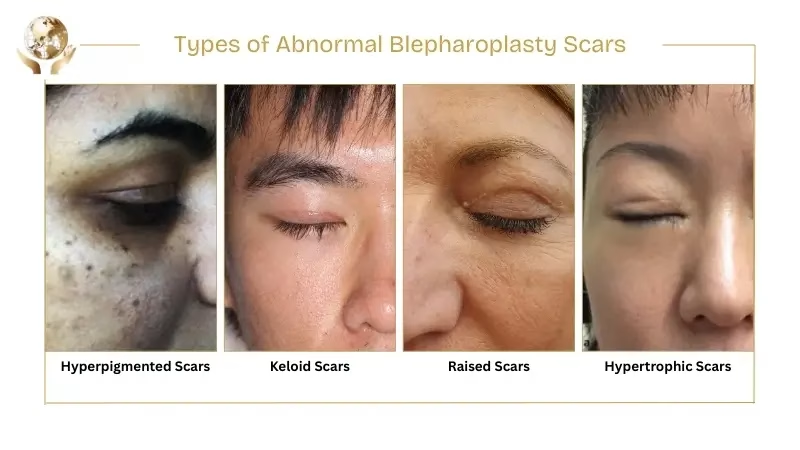
Hyperpigmented Scars
The hyperpigmented scars look way darker than the skin around your eyes. The cause is usually extra melanin (skin pigmentation) during healing, and they’re more visible in dark skinned people.
Keloid Scars
The keloid scars usually grow beyond the incisions, and they’re very rare in most cases. People who are prone to these scars tend to get them, but not everyone. They’re thick, raised and can be itchy or painful.
Raised Scars
When the skin produces too much collagen around the eyelids, raised scars appear. They feel bumpy, rigid or lumpy compared to flat scars. They’re normal and usually resolve on their own. If they don’t, they may need treatment.
Hypertrophic Scars
The last type of lump scars after blepharoplasty is the hypertrophic scars, which are raised and stay only within the original cut area. They also look red or purple at first, and with care, they can flatten and fade in color over time.
See Also: Get Rid of Crow’s Feet Eyes
What Causes Lumpy Scars After Blepharoplasty?
Scars after blepharoplasty are caused by scar tissue, sutures, healing gel reaction, infections or foreign bodies.
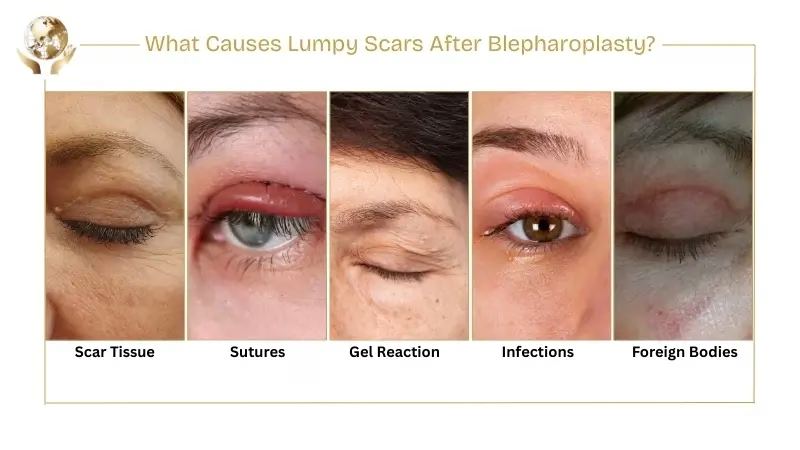
Scar Tissue
Excessive scar tissue formation can cause a lumpy scar on the eyelid, which often appears red or raised.
Sutures
Skin can react differently to the sutures, leading to the bump scars. It usually resolves after sutures dissolve or are removed.
Healing Gel Reaction
If the healing gel is used to speed up the recovery, then it can also react with the skin, causing irritation or a small bump at the incision site.
Infections
Infections can also lead to swelling or bumps. They need medical attention to prevent worsening.
Foreign Bodies (Ointments)
Foreign bodies, such as ointments, can clog the skin and cause small lumps or trapped material at the incision site.
What Affects How Scars Look?
These factors affect the appearance of the scars after blepharoplasty.
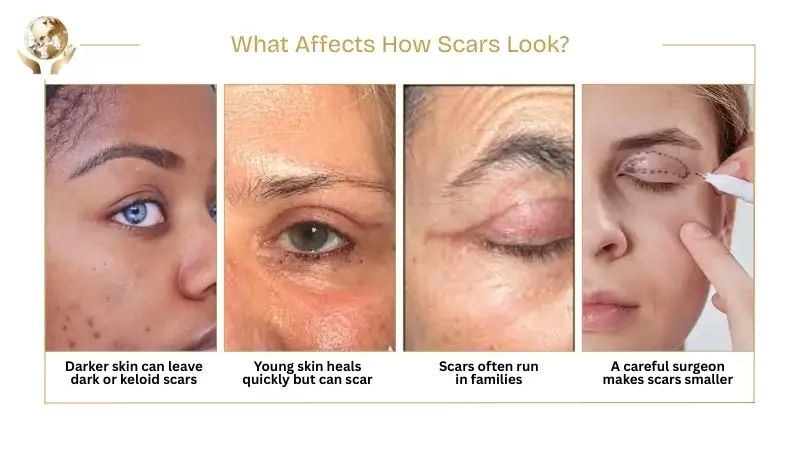
- Darker skin can leave dark or keloid scars; lighter skin may look red.
- Young skin heals quickly but can scar; older skin heals more slowly.
- Scars often run in families.
- A careful surgeon makes scars smaller.
- Good aftercare keeps scars lighter and less visible.
See Also: Bad Blepharoplasty Scars
How To Fix Lump Scars After Blepharoplasty?
There are different treatments available for lumpy scars after blepharoplasty, such as silicon scar treatments, massage, laser treatments, steroid injections and scar revision surgery.
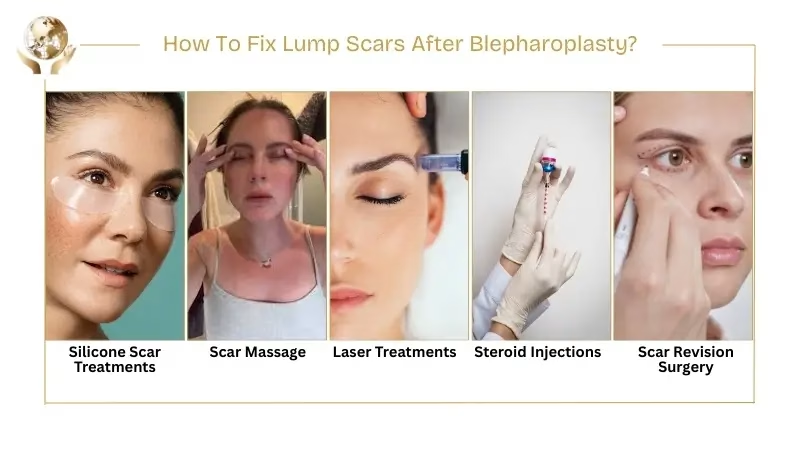
Silicone Scar Treatments
This treatment includes gels, creams or sheets that you apply to your scar, forming a protective layer. They keep the scars hydrated and control the collagen, flattening and softening them.
Scar Massage
A simple massage can also help you get rid of the lumpy scar after eyelid surgery. Just gently massage in circular motion on the scars, which breaks down the thick collagen and speeds up the healing.
Laser Treatments
The laser treatments are also effective for scars after the surgery. They use light energy to reduce the redness, pigmentation and raised texture of the scars. They also stimulate collagen for smoother skin.
Steroid Injections
Steroid injections are an effective solution to the keloids or the hypertrophic scars as they not only reduce the inflammation but also the collagen build-up, smoothing out the scars. They also help in reducing the pain.
Scar Revision Surgery
Scar revision surgery is a type of surgical operation that removes the old scar and re-stitches the wounds carefully.
Sometimes, it uses grafts or flaps to fix the scars and the structure of the eyelid. It’s a complex procedure that you should only turn to when other methods we’ve discussed so far don’t work.
See Also: Blepharoplasty Infections
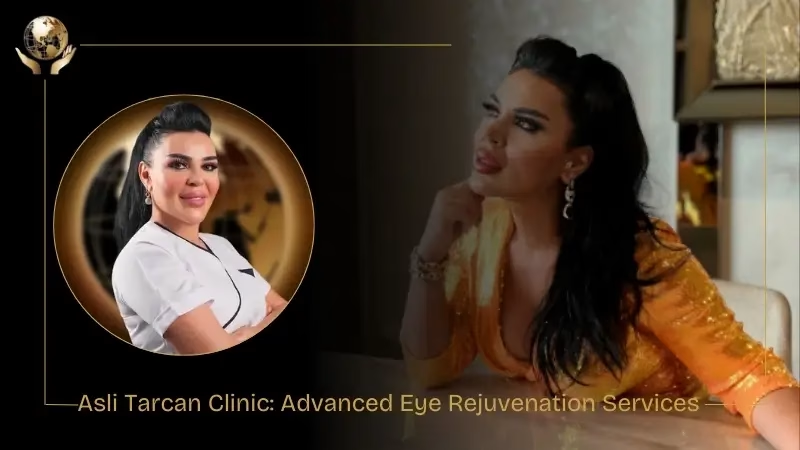
Asli Tarcan Clinic: Advanced Eye Rejuvenation Services
What causes lump scars after blepharoplasty? The scars after surgery are usually caused by scar tissue, sutures, healing gel reactions, infections, foreign bodies like ointments, or hyperpigmentation.
They can also result from hypertrophic, raised, or keloid scars, as well as factors like genetics, skin type, age, surgical technique, and post-operative care. The solutions to the scars after eyelid surgery are silicone scar treatments, scar massage, laser treatments, steroid injections, and scar revision surgery.
If you have under-eye circles, sagging eyes, or droopy eyelids, contact Asli Tarcan Clinic.

This article is medically reviewed by Ophthalmologist Dr. Mehmet
See Our Doctors & Surgeons
How do you get rid of lumps after blepharoplasty?
The lumps can be treated with many treatments such as steroid injections, massage, laser treatments or Silicone.
How long does it take for blepharoplasty scars to flatten?
The normal scars take 3 to 6 months to mature and up to a year to finally fade.
What is a keloid scar from blepharoplasty?
It’s a rare thick scar that grows beyond the incision and is often itchy and raised.






